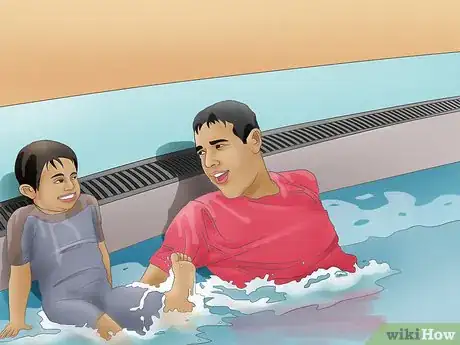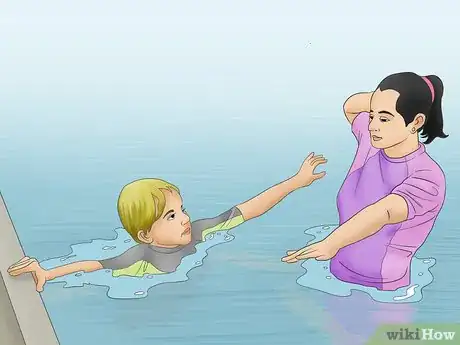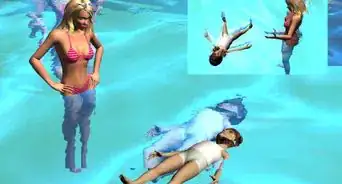This article was co-authored by Paul Chernyak, LPC and by wikiHow staff writer, Jennifer Mueller, JD. Paul Chernyak is a Licensed Professional Counselor in Chicago. He graduated from the American School of Professional Psychology in 2011.
There are 25 references cited in this article, which can be found at the bottom of the page.
wikiHow marks an article as reader-approved once it receives enough positive feedback. In this case, 97% of readers who voted found the article helpful, earning it our reader-approved status.
This article has been viewed 91,504 times.
Autistic children often are prone to wandering, making water a particular hazard. Drowning was the leading cause of death in autistic children under 14, according to the National Autism Association.[1] Apart from safety concerns, swimming can be an enjoyable and even therapeutic experience for autistic children. While some parents are able to teach their kids to swim safely in shallow areas, others might prefer help from a professional. Consider looking for a swim instructor who has experience with kids with disabilities, especially autism.[2] [3] [4]
Steps
Helping the Child Feel Comfortable
-
1Talk to the child about swimming. Use a social story to talk to them about learning how to swim and what to expect at their swimming lesson. Social stories are an effective way to get your child accustomed to the idea of taking swimming lessons.[5]
- You can find books at the library or examples of social stories online that you can adapt to your child's situation, or you can write your own.
- Include each step of the process, including the days and times the child will be participating in swim lessons, where those lessons will take place, how they'll get there and back home again, and what will happen at the lessons.
- For example, your story might start: "My name is Andy. Each Saturday I take swimming lessons at the YMCA. My mommy drives me to the YMCA in the blue car. We say hello to the person at the desk. I go to the locker room and change into my wetsuit. My mommy keeps my things for me while I go to the pool. At the pool I meet my instructor. I stand beside the pool until my instructor says I can get in the water."
- Read the story with the child several times before the lessons begin, and answer any questions they might have about the process. You may want to incorporate some of those answers into the overall story.
-
2Show the child photos or videos of people swimming. Use pictures to augment your social story and continue the process of getting your child used to the idea of swimming lessons.[6]
- Photos and videos can be particularly helpful to nonspeaking children and visual thinkers.
- It can help to go to the pool where the child will be taking swimming lessons and take pictures there.
- Take photos of all the areas where the child will need to go during the course of their lesson, including the locker or changing rooms, showers, and the pool itself.
Tip: When choosing videos, make sure that the volume isn't too loud and that the content is relatively peaceful and not scary. Choose a video length that's appropriate for the child's attention span. Keep the volume low if they're sensitive to noise.
Advertisement -
3Take the child to the pool. Many autistic children do better in a new environment if they're given the opportunity to become familiar with the place without any expectations. Introducing your child to the location where swim lessons will take place can help them become more comfortable.[7] [8]
- Try asking "Do you want to just look around, or would you like to try playing in the water?"
- How many visits you'll need depends on the child. You should have a general idea based on previous experiences in which you've taken your child to a new place.
- Some kids will be fine if you simply go to the first lesson a few minutes early and give them a chance to walk around and acclimate themselves.
- Other kids need several visits before they will be comfortable enough to participate in the swimming lessons.
- If the child is having an exceptionally difficult time adjusting, motivate and reward the child with a sweet treat or new toy after visiting the pool so they associate the pool with something positive.
-
4Let them watch swimming lessons. Many autistic children will benefit from having the opportunity to watch a swimming class in progress before they participate in one themselves.[9]
- Let the pool or swimming club know that you plan to take your child to observe lessons. Your child also may be able to meet their instructor and learn more about what will happen.
- Point out activities the children in the class are doing, and when the teacher is giving instructions.
- You also can use this opportunity to point out proper behavior around the pool, including how to walk around the pool deck and how to enter and exit the water.
Tip: You can also use this opportunity to watch the instructor's teaching style. For example, if your child is very sensitive, they would benefit from a gentle and patient approach, while if your child is on the wild side, they might need someone who can redirect them and set firm rules.
-
5Play in the pool with the child. Have some fun in the water before teaching the child to swim. It helps for the child to see you in the pool so that they can see that it's safe and potentially fun. Try bringing a few toys and chatting about things that the child enjoys to help them relax and enjoy themselves.
- Lots of exposure to water will help the child learn to feel comfortable with it.[10]
- Give them the opportunity to play with you or play alone. Depending on the kid's mood and personality, they might need some time to play alone and stim with the water to help them feel comfortable.
- Make pool toys available and let the child choose whether and which to use.
Accommodating Sensory Issues
-
1Eliminate unnecessary noises. Pools – especially indoor pools – can be noisy places with a lot of auditory distractions. Having private lessons in an empty pool is one way to help, but it may be out of reach for you financially.[11] [12]
- Many swimming instructors use whistles and communicate with students in loud voices, which can be intimidating or even physically painful for the autistic child.
- If your child is sensitive to sound, make sure you let the swim instructors know well in advance of the swimming lessons so they can accommodate.
- Don't pursue lessons with an instructor who refuses to accommodate the child. They may be impatient and insensitive in other areas too, and the child might have a bad experience as a result. Look for a better instructor.
Tip: If indoor pools have too much echo and noise, try an outdoor pool instead.
-
2Try out a wetsuit if swimsuits are uncomfortable for the child. Many autistic children are more comfortable in the water when wearing a wetsuit, as opposed to a more traditional swimsuit. Wetsuits keep them warm and hug the body, making the child feel more secure.[13]
- Wetsuits look more like clothing (as opposed to underwear) and may be less likely to ride up, so the child might feel more comfortable wearing them.
- High-tech wetsuits aren't necessary for normal swimming activities. They may be sold at a local discount chain store, though they may only be available in the summer.
- Try letting the child wear the wetsuit around the house for a while before starting swimming lessons to help them get comfortable with it.
-
3Advocate for adjustments to rules and policies. Some pools or swim clubs may require particular attire or gear (like swim caps or goggles) for swimming lessons that's uncomfortable or anxiety-inducing to the child.[14] [15]
- Let the child try the gear before asking for an exemption. They may be okay with wearing it.
- For example, you could say "I understand that you require all students to wear goggles. My daughter is autistic and although we have introduced her to the goggles, she finds them painful and has an intense emotional reaction, sometimes to the point that she'll throw them away from her. I would appreciate it if you allowed my daughter to participate without goggles."
- Request an exemption if your child rejects the gear or has an intense response to it. If the pool or swim club is not willing to make an exception for your child, you may need to get swim lessons elsewhere.
Did You Know? Sometimes autistic kids need more time to acclimate to a piece of gear or clothing. Try letting them play with it and explore it in their own time. Sometimes they'll end up getting used to it. Other times, it'll cause sensory pain and they can't adjust (just like you probably couldn't adjust to shoes made out of blunt knives), so they shouldn't be forced.
-
4Have the instructor adapt techniques to accommodate sensory issues and other needs. As the instructor teaches various strokes and swimming techniques to the class, there may be some things that your child has difficulty with specifically because of their sensory issues.[16]
- If the child is doing well with most techniques but struggles with one, it may be that the technique is too uncomfortable or that it's a motor skill issue. If possible, ask why it's hard for them.
- For example, many autistic children have a difficult time putting their head under the water. While doggy paddling may be less efficient than other swimming strokes, it's better than nothing.
- See if breaking it into steps helps. For example, if the child is nervous about putting their head underwater, they could try putting their chin underwater, then just the mouth, then both the mouth and nose, then the face only, and then the entire head.
- Don't force it if it's not working. To avoid drowning, the child should know how to doggy paddle and float on their back. Everything else is optional.
-
5Allow the child to use coping methods. Autistic children often spin in place, flap their hands, or make other repetitive movements ("stimming") to cope with sensory overload, or to calm themselves when they are feeling anxious.[17] [18] This helps them self-regulate and feel comfortable. In the pool, stimming can help the child relax and enjoy the water.
- Particularly in the swimming environment, the instructor should take care not to discourage an autistic child from stimming.
- If your child has particular fidgets or other items that they use, get permission for them to take one or more of those items to the pool with them (provided they're waterproof). These items can serve as a comfort to your child as well.
- Observe the classes while your child is participating. If your child's behavior gets disruptive, encourage them to leave the pool until they can calm down.
- In some situations, adult family members may need permission to be in the pool with the child, particularly if the child is nonspeaking or prone to dramatic outbursts.
Tip: Watching the child's stimming can help you estimate their comfort levels. Intense or agitated stimming can suggest discomfort and possibly the need for a break. Happy or playful stimming can indicate that the child is enjoying the water and feeling comfortable.
-
6Provide a quiet room for the child to take a break. Make sure there's a place at the facility where the child can go if they need to be alone and remove themselves from an overstimulating environment.[19]
- It doesn't necessarily have to be an entire room, but it does need to be an area where other people won't intrude.
- It may help to bring a favorite object or two (like a blanket, stuffed toy, or fidget toy) to swim lessons so the child can have them during a break.
- Make sure the child understands where their safe place is, and how to get there from the pool.
Communicating with Autistic Children
-
1Create a routine for each lesson. Each lesson should include a warmup and cool-down routine. These should be the same routines for every lesson and can be as simple as splashing water, kicking on the step, or blowing bubbles. Routine will help calm the child's nerves and increase confidence in completing tasks.[20] [21]
- Many swimming programs designed for children with special needs include these sorts of routines as a matter of course, such as starting and ending each lesson with a song.
- If the program itself doesn't include a routine such as this, you can create one for your child by doing specific things before and after each lesson.
-
2Connect through the child's special interests. Autistic people are often very passionate about a particular object or topic of interest. Using a child’s interests may be the most important technique the instructor can use to capture and hold their attention during lessons.[22]
- If the child has special interests that have any connection to the water, let the child's instructor know about them so they can integrate them into the lessons.
- Even if the child's special interests have nothing to do with water or swimming, the instructor still can connect with the child by mentioning them.
- For example, a parent might tell the child's swimming instructor "If you want to engage my child, ask her to tell you about castles."
-
3Demonstrate the correct technique. When teaching autistic children, it is best to avoid the "right way versus wrong way" teaching technique. One characteristic of autistic children is that they pick up many details, and sometimes struggle to sort the irrelevant ones from the relevant ones.[23]
- Swim instructors often demonstrate strokes to their students by saying "do this – don't do this." This can confuse autistic kids.
- Letting the child see it from several angles may help the child, especially if they're a visual thinker. For example, the child might get to see it from the front, from the side, and from behind.
-
4Provide clear and straightforward instructions. The instructor should speak clearly in a moderate tone of voice without shouting. Explain to the instructor that shouting may cause pain or confusion for your child.[24] [25]
- Swimming instructions should be straightforward, without any metaphors or sarcasm, which can be confusing.
- Many strokes involve several different steps. It may be helpful to the autistic child if the stroke is broken down into each of its constituent parts and they have the opportunity to practice each part separately before combining them together.
- For example, it might be helpful for the child to practice the stroke with each arm individually, then practice kicks while holding onto the side of the pool, then combining the motions to move across the pool.
-
5Use visual cues. Autistic children may struggle to process auditory input, so visuals help them catch all the useful information. Many autistic children are visual learners who will benefit from seeing rules, techniques, and expectations in picture format.[26] [27]
- An action figure with movable arms and legs can be a good visual aid, because the figure can help demonstrate the stroke.
- Your child can move the action figure to replicate the stroke, giving them a strong, three-dimensional visual image of what they should do.
- Allowing the child to manipulate the action figure also engages their sense of touch, making it easier for them to understand what they're expected to do.
-
6Recognize progress and achievement. Autistic children need to be told when they've met expectations and done something correctly. Even the smallest progress should be rewarded so that they're encouraged to continue.[28] Try to create a positive experience full of praise and fun. You can even promise that the child will win something special once they've learned to swim.
- Instructors should offer frequent and consistent praise when the child does something well.
- Parents can decide to set up a reward system, such as telling the child that they'll get a new toy after learning to doggy paddle.
- Be cautious about overdoing rewards. Offering too frequent rewards for little steps may pressure the child to please you even if they're uncomfortable or stressed out and in need of a break. You're trying to nudge them, not control them.
- Focus rewards on completion, not mood or whether their behavior is ideal. Sometimes kids need to cry, take breaks, or show you that they're stressed. You want an assertive child who expresses themselves, not a people pleaser.
Expert Q&A
-
QuestionMy Foster child is almost ten and he has CP and Autism. He does not want his face in the water, even though he drinks the pool water on purpose. How can I teach him the breathing part?
 Paul Chernyak, LPCPaul Chernyak is a Licensed Professional Counselor in Chicago. He graduated from the American School of Professional Psychology in 2011.
Paul Chernyak, LPCPaul Chernyak is a Licensed Professional Counselor in Chicago. He graduated from the American School of Professional Psychology in 2011.
Licensed Professional Counselor If he is already in the pool and putting his head in the water, then he's almost there. You may want to get into the water with him and model the breathing part. Reward him every time he does it as well. Take small steps and praise him at every step. It may take some time and patience before he does it correctly.
If he is already in the pool and putting his head in the water, then he's almost there. You may want to get into the water with him and model the breathing part. Reward him every time he does it as well. Take small steps and praise him at every step. It may take some time and patience before he does it correctly.
Warnings
- If the only way to get the child to do what you want is to use a lot of rewards, that means the child is not comfortable or internally motivated. You'll want to investigate why they're so reluctant to swim. An unmet need, an unaddressed fear, or a source of discomfort may be making it hard for them.⧼thumbs_response⧽
- Put safety first. Until they are good at both swimming and assertively communicating things like "I'm tired" or "I need a break", don't take your child near deep water without a lifeguard watching unless you are professionally trained in rescue swimming.⧼thumbs_response⧽
References
- ↑ https://www.autism-society.org/the-issue-of-wandering-for-individuals-living-with-autism/
- ↑ https://www.pathfindersforautism.org/docs/Teaching-Swimming-to-Studens-with-Autism.pdf
- ↑ https://health.osu.edu/discovery-and-innovation/research-advances/swim-lessons-for-autistic-kids-could-decrease-drowning-risk
- ↑ https://scholarworks.uni.edu/cgi/viewcontent.cgi?article=1005&context=etd
- ↑ https://www.healthychildren.org/English/safety-prevention/at-play/Pages/Swim-Lessons.aspx
- ↑ https://www.betterhealth.vic.gov.au/health/healthyliving/swimming-health-benefits
- ↑ https://www.aane.org/five-tips-to-promote-pool-safety/
- ↑ https://raisingchildren.net.au/autism/behaviour/understanding-behaviour/changing-routines-asd
- ↑ https://www.healthychildren.org/English/safety-prevention/at-play/Pages/Swim-Lessons.aspx
- ↑ https://autismswim.com.au/2017/04/11/tip-sheet-increase-water-exposure-home-early-stages-swim-education/
- ↑ https://www.autismcrc.com.au/sites/default/files/inline-files/Guidelines%20for%20Creating%20Autistic%20Inclusive%20Environments%20(002).pdf
- ↑ https://scholarworks.uni.edu/cgi/viewcontent.cgi?article=1005&context=etd
- ↑ https://www.thprd.org/pdfs2/document2720.pdf
- ↑ https://www.nspcc.org.uk/globalassets/documents/advice-and-info/underwear-rule-parents-guide-children-autism.pdf
- ↑ https://www.healthychildren.org/English/health-issues/conditions/Autism/Pages/Autism-Wandering-Tips-AAP.aspx
- ↑ https://www.autism.org.uk/advice-and-guidance/professional-practice/occupation-therapy
- ↑ https://www.childautism.org.uk/
- ↑ https://unesdoc.unesco.org/ark:/48223/pf0000182975
- ↑ https://www.sju.edu/news/sju-unveils-autism-break-room-support-sports-fans-autism
- ↑ https://www.waterford.org/education/15-activities-teaching-strategies-and-resources-for-teaching-children-with-autism/
- ↑ https://thompsoncenter.missouri.edu/2015/11/children-with-autism-dive-into-new-adaptive-swim-program/
- ↑ https://raisingchildren.net.au/autism/behaviour/understanding-behaviour/obsessive-behaviour-asd
- ↑ https://ibcces.org/blog/2016/07/15/behavior-strategies/
- ↑ https://udservices.org/employees-with-autism/
- ↑ https://childmind.org/article/how-to-give-kids-effective-instructions/
- ↑ https://www.aoa.org/news/clinical-eye-care/diseases-and-conditions/detecting-the-signs-of-autism-at-earlier-age-using-visual-cues?sso=y
- ↑ https://www.aoa.org/news/clinical-eye-care/diseases-and-conditions/detecting-the-signs-of-autism-at-earlier-age-using-visual-cues?sso=y
- ↑ https://www.helpguide.org/articles/autism-learning-disabilities/helping-children-with-learning-disabilities.htm
About This Article
To teach autistic children to swim, start by introducing swimming slowly through stories, photos, videos, and letting the child observe people in pools. When you think they're ready to get into the pool, put them in an inexpensive wetsuit, which usually helps them feel more secure in the water. Construct swimming lessons around specific routines that include both warmup and cool down exercises and try to avoid changing routines too much. Provide clear, straightforward instructions and demonstrate the correct technique for each stroke. Keep in mind that you may need to adapt the lessons depending on the child's particular sensory issues. For tips on communicating with autistic children, read on!















































































Medical Disclaimer
The content of this article is not intended to be a substitute for professional medical advice, examination, diagnosis, or treatment. You should always contact your doctor or other qualified healthcare professional before starting, changing, or stopping any kind of health treatment.
Read More...